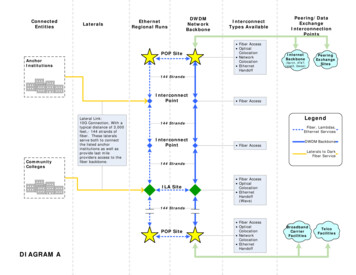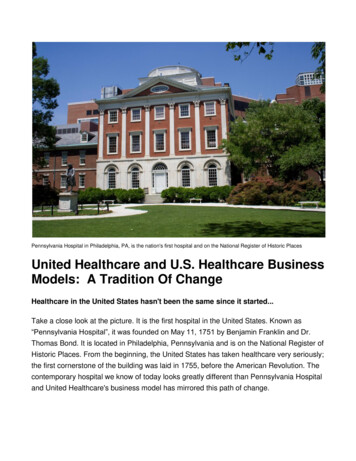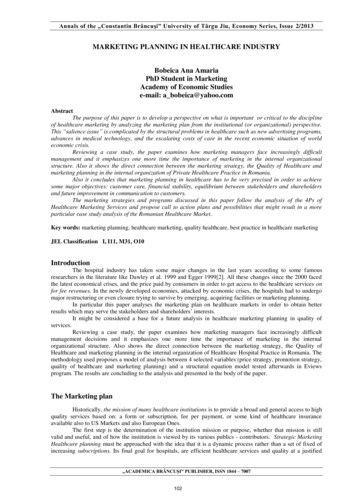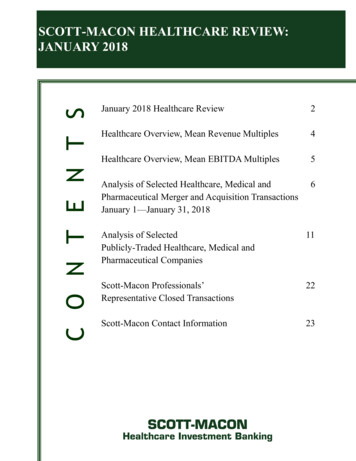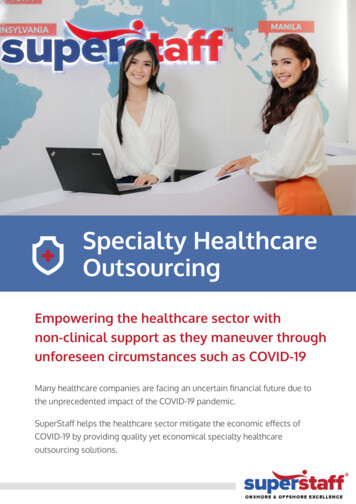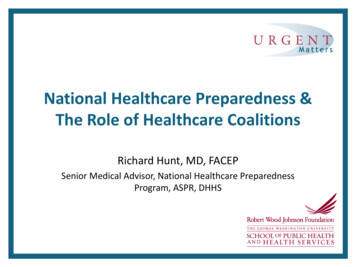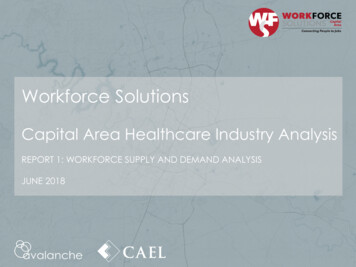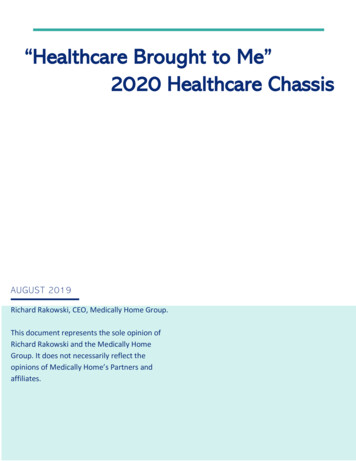
Transcription
“Healthcare Brought to Me”2020 Healthcare ChassisFirst-Ever, Non-Partisan, PoliticsFree American UniversalHealthcare PlatformAUGUST 2019Richard Rakowski, CEO, Medically Home Group.This document represents the sole opinion ofRichard Rakowski and the Medically HomeGroup. It does not necessarily reflect theopinions of Medically Home’s Partners andaffiliates.1
The Big IdeaThe Organizing Principle to Rapidly Deploy a New System of Medical Care“Patient Power”meets“Distributed Healthcare”2
Patients as Organizing PrincipleThe Time has Come for Three Powerful Voices to Come TogetherVotersPatientsConsumersAmerican voters are fed upwith ineffective healthcarereform promises frompoliticiansPatients endure unacceptablelevels of dissatisfaction,negative outcomes andadverse eventsPatients are rapidly taking onthe mantle of (consumer)payers, as they experienceexplosive growth in their outof-pocket spending forhealthcare3
Patient PowerIt’s Time to Make the Patient the Subject vs. the Object of Healthcare Maximize patients’ engagement in their own care Shift delivery to where patients want and need care Reimburse for services that support patients where and when theyneed care Make patients’ satisfaction paramount to care delivery’ssuccess/failure Give patients real choice fueled by transparencyGUIDING PRINCIPLES The problem the current healthcare system: Is focused on what we do “to” patients vs. “who” they are and what they “want and need” Uses a reimbursement system that rewards institutional based care vs. care delivered tosupport superior patient experience, outcomes and costs Does horrific harm to patients – adverse events, deaths, cognitive decline, physical deconditioning The heart of the solution the patient as the center of care Design care delivery with the patient at the center Build and deploy systems and technology centered around patients’ homes andworkplace Empower patients to make the best choices for their health Reimburse for care, services and social support that support the patient and his/hermaximum engagement and outcomes4
Decentralization as an Organizing PrincipleAmazon has Answered the Question About the Value of Decentralization Amazon Scale 178 billion in sales 5% of all retail sales/47% of all ecommerce Generates 26 million consumer transactions per day 100 million Alexa devices sold so far Amazon Decentralization Spends 28 billion/annum in shipping 1million new sellers added in 2018 95 million Americans have Amazon Prime memberships. Amazon Cost Power - Whole Foods prices dropped 43% after Amazonacquired the grocery chain5
America Will Create a True System of CareAround the Fusion of these Two Ideas COSTS - A decentralized system will result in radically reduced costs thatwill create substantially expanded access OUTCOMES – The system of care will significantly improve patientengagement, outcomes and patient experience UNLOCKING POWER – the system of care will transform how we: More reliably and rapidly access care More intelligently pay for care Better align all the stakeholders of care Enable patients to become truly empowered consumers ofhealthcare6
Key Elements of a New Healthcare SystemSelf-Organized by Empowered Patients Meeting Distributed Healthcare Deliveredon a Technology-enabled Distributed Chassis of Care The value of each of these elements of healthcare delivery and paymenthave already proven themselves in a siloed manner. The newly proposed U.S. Healthcare System integrates many of theseelements as part of a holistic healthcare policy and intelligent system ofcare delivery. The newly proposed elements of care in the proposed model will helptransform the currently non-sustainable siloed care delivery model into atruly sustainable system. This system can concurrently stabilize healthcarecosts, while building a significant new American export business.7
Transform Healthcare Deliveryvia a New Decentralized Chassis of Care DeliveryThe ProblemSystem economics - Low margin, (high fixed cost) facility-based care delivery (e.g., hospitals and skilled nursingfacilities) is no longer sustainable. As a growing public payer mix drives down the facility margins even further.Outcomes – High rates of adverse events and low patient satisfaction are common in the current system. The #2cause of death in hospitals are from adverse events.Patient economics - High care delivery costs in the current model create massive financial (cost sharing) burdens forpatients and their families.Employers – large and growing employer costs for healthcare are significantly impacting productivity and ability toeffectively compete with U.S. based employees.The SolutionDecentralize - Shift the principle sites of costly/centralized medical care (hospitals, nursing homes and rehab facilities)to lower cost decentralized sites of medical care where patients prefer to be cared for (e.g., patient homes).New Chassis of Care Delivery – Using proven technology and logistics systems, deliver medical care to remote (vs.centralized) sites of care using the following care platform elements that are integrated with one another into a holistic,high impact true system of care that operates 24/7.Broad use cases – De-centrally deliver a wide(medical intensity) range of care delivery usecases (e.g., from primary care, ED visits, palliativecare and home hospitalization)Targeted net impact – Reduce total healthcare system costs by 90 billion (which willsignificantly benefit employers, people andeconomy, while improving outcomes, savinglives and significantly improving healthcareoutcomes). Finally, create the chassis for avibrant new export business.Unlocking Power – This technology-enabled clinical and operational healthcare deliverymodel has the power to catalyze, enable and unlock other critical elements of a sustainablehealthcare system( e.g., greater-more targeted access, value-based delivery/rationalreimbursement, transparency and the platform to intelligently evolve the current asset heavydelivery model).8
Transform Healthcare Deliveryvia the Deployment of a Laser-Focused Paredo Delivery ProgramThe ProblemAsymmetry - While patients with chronic diseases (e.g., heart failure, diabetes, COPD) and cancer only represent 20%of Americans, they consume 70% of the 3.5 trillion in U.S. healthcare spending. Like the famous Paredo factorsparsity law (where 80% of the effects come from 20% of the causes), the American Paredo population is worthy ofspecial care delivery and reimbursement focus.Unique needs – Patients with chronic disease and cancer have much different needs than those Americans whooccasionally get sick and require medical care. Paredo patients are: (i) often frail and elderly, (ii) highly sensitive tomedication adherence and lifestyle and social determinant considerations, (iii) often experience acute medicalexacerbations requiring hospital level medical care and, (iv) see many specialists above and beyond their primary carephysician. Paredo patients often require intensive care support from family members. Most Paredo patients are neverreally cured of their medical challenges, but instead, can be reliably managed with the right combination of medical andnon-medical treatments.Current system challenges – The current hospital-centric system of care and the reimbursement model that supportsit are rife with specific challenges for Paredo patients. These challenges include: (i) adverse events that are common ininstitutional sites of care (infection, falls, sleep challenges, cognitive decline, social isolation, etc.), (ii) access to rapid24/7 medical care is only available at hospitals, (iii) high patient reimbursement co-pays for medication are often atodds with the positive outcomes, and (iv) no reimbursement for critical care support functions that help ensure thesepatients do not end up in the hospital (e.g., care support at home and disease related nutritional support).The Solution365/24/7 care (vs. episodic) – Provide a medical care program for these patients on a 365/24/7 basis as theyrequire. The proposed (proven) program of care has dedicated teams of clinicians (e.g., physicians, NPs, physicianassistants, pharmacists) and social workers that are configured to keep Paredo patients healthy.Use the proposed Decentralized Care Delivery Chassis – Provide 365/24/7 access to care from a centralizedbiometrically-enhanced telemedical command center that supports the ability to rapidly dispatch care to these patientswhen and where they need it.New reimbursement policies – Align incentives and reimbursement mechanisms for both patients and providers ofcare that encourage the proposed model of care and the associated proven behaviors and therapies that create positiveoutcomes with a supportive return on investment (e.g., reimburse for care support at home, patient monitoring, andfood for patients with nutrition sensitive disease).Targeted net impact – Net healthcare savings potential of 100 billion annually, supported by dramatically improvedpatient care access, engagement, satisfaction and outcomes.Utilizing the Chassis – The proposed technology-enabled clinical and operationalhealthcare delivery chassis is designed to monitor and connect patients and their families toa 24/7/365 medical command center that can rapidly dispatch to patients at bedside. Thisubiquitous surveillance of patients who are chronic and require 24/7 access to care,meaningfully overcomes most of the dominant challenges that chronic/co-morbid patientshave with the current hospital-centric model of care.9
Transform Healthcare Deliveryvia the Conversion of Hospitals into Profitable Health CampusesThe ProblemHospital fixed costs – 65% of a cost of a hospital stay are consumed by the fixed costs associated with large andcentralized bricks and mortar industrialized care delivery sites of medical care. These costs create a myriad ofchallenges for patients, providers and payers alike. These challenges include: (i) inadequate time in the hospital toresult in a reliable recovery from acute illness, (ii) adverse events, (iii) decline in physician satisfaction, (iv) pooroutcomes, (v) suboptimum patient satisfaction and, (vi) large care costs post hospital discharge.Mismatched supply and demand – In most U.S. hospital markets, hospitals struggle with either inadequate volume(under capacity) to achieve financial sustainability or too much volume (over capacity), which creates a host of quality,financial and regulatory challenges. Right-sizing hospitals with such a large fixed cost burden combined with volumevariability is no small task.Payer mix is going the wrong way for hospitals – as population aging continues to gain momentum and the rolls ofthe more needy in society continue to be a large factor in medical care delivery, patients covered by public payers(Medicare and Medicaid) are growing in volume. With that growth the ability for hospitals to operate with an acceptableprofit margin is growing more and more vexing every day. Medicare and Medicaid reimbursement levels are intentionallylower vs. commercial insurers. The accelerating effect of public payer reimbursement strategy with hospitals that havevery high fixed costs is a fundamental challenge to traditional hospital sustainability.Hospitals are the largest employer – In most American communities, the hospital is the largest single employer andas a result there is strong public, political and organized labor pressure to keep hospitals open, regardless of theirfinancial viability.The SolutionHealth Campus – Imagine a modern and appealing campus containing: (i) a radically-reduced hospital footprint (40%less beds) that is integrated with (ii) housing that provides patient and their families with assisted living, skilled nursingand memory care services and (iii) housing for physicians, nurses and ancillary medical services providers who areemployed at the campus, (iv) health club facilities and, (v) retail providers (restaurants, theater and shops), allbenefitting from captive traffic residing on the campus. This new health campus blueprint would allow hospitals torationally transition from their currently unsustainable model into one that integrates a proven multi-use formula forsuccess.REITS need to go shopping – Given a host of very favorable market dynamics, Real Estate Investment TrustCompanies (“REITs”) that purchase healthcare real estate assets and then lease them back to healthcare providers astheir business model are the ideal platform for the wholesale conversion of traditional hospitals into a more financiallyattractive (healthcare campus)model. Public and tax policy need to support this transition.Targeted Net Impact – The deployment of this model to 25% of the hospitals operating below ideal capacityutilization will result in 25 billion significant savings to the healthcare system.Utilizing the Chassis – The proposed technology-enabled clinical and operationalhealthcare delivery chassis is designed to support high acuity medical care in a decentralizedmanner. The health campus model will use the decentralized care chassis to provide hospitallevel care in patients in homes both on and off campus, This approach will provide asignificant reduction in the reliance on bricks and mortar hospital level care.10
Transform Healthcare Paymentvia the Creation of a National Public-Private Payer PartnershipThe ProblemThe existing payer model does not work – The U.S. spends 496 billion on the payment layer of our healthcaresystem. This includes all the revenues of all private health insurance companies, plus the cost of Medicare and Medicaidadministration. This extraordinary level of spending consumed to administer payments to healthcare providers on amostly fee-for-service basis, (regardless of outcomes or value). The fee-for-service healthcare economy needs to morerapidly transition to a model based on value (measured by outcomes). While the movement to value has begun, it is inits infancy of implementation.Employers are struggling – Since WW II, U.S. employers were saddled with the responsibility of paying for employeehealth insurance. In the 1970’s as healthcare costs began to rise, employers concerned about their financialperformance and competitiveness, set the stage for the creation of the managed care industry. This new layer of activityand cost to the healthcare system was introduced to help employers stem the tide of healthcare cost inflation. Whilewell-intended, under a managed care system, employers have seen explosive healthcare cost escalation, which in turn,has forced employers to reduce employee benefits and with this reduction: (i) the financial burden on employees andtheir families is now a true national crises and at the same time (ii) has reduced employer competitiveness.Doctors as financial stewards? – while there are endless stories about health insurance companies denying patientsaccess to medication, procedures or services, there are many more stories of healthcare providers ordering anddelivering care without any sensitivity to the financial implications of those decisions on all patients, our healthcaresystem and economy. Most providers of care do not view themselves as the stewards of their patients’ money, but thetruth is, with rapidly escalating patient cost sharing (growing co-pays and deductibles), physicians are in a role offinancial steward (whether they know it - like it or not).Exotic solutions – exotic costs – U.S. medical technological innovation (with diagnostics, devices, drugs and surgicalprocedures) continue to provide solutions, cures and hope for millions of Americans and non-Americans around theworld. The costs to develop these solutions are often measured in billions of dollars, and frequently, these developmentinvestments do not come to full fruition. American healthcare policy needs to recognize the high costs required forbreakthrough innovation requires a reasonable return on investment (“ROI”), or innovation investments will behampered. A pending healthcare system crises on the horizon that stems from the issue of innovation, investment andROI is the one related to drug resistant bacteria (a lot of which is generated in the hospital setting). Current antibioticproduct efficacy is severely challenged, as more and more strains of virulent infections are proving resistant to existingantibiotics. The ROI for a new antibiotic compared to an exotic cancer therapy is not attractive, as we find ourselvesvulnerable to growing challenges to infection risk.Innovation is not in the DNA of monopolies or governments – A payer and payment solution needs to recognizethat rapid and effective innovation in healthcare will neither come from a “Medicare-for-all” health insurance strategy,nor will it come from a single source private sector solution alone. Just like the public private partnership that put thefirst man on the moon, we need to recognize the power of our people, ingenuity, non-controlled economy and provenefficacy of public-private partnerships, in any healthcare system solution we configure.11
The SolutionUniversal coverage – Healthcare is an American right and not a privilege. All American citizens, regardless of age,race, ethnicity, income or medical condition, deserve nothing less than healthcare coverage.Remove death and dying from the healthcare system – End of life care requires a completely different social andspiritual care support model than healthcare is designed for. It is time to recognize and shift our care delivery tohumanely manage end of life with dignity and intelligence. An intelligent and humane healthcare system demands moreorganized systems to appropriately transition patients to home-based palliative and hospice care, when the time comes.Public/private partnership – Convert the current Medicare and Medicaid programs into the public portion of a singlepublic payer partnership. The public portion will be responsible for the regulatory framework, healthcare policy, paymentlevels and compliance aspects of care delivery. There will be a competitive bidding process for the partners that willoperate the private portion of the partnership. The private payer partners will manage the value-based delivery systemand reimbursement services. These private entities will be rewarded with (uncapped) profits based on quality and valueoutcomes. Bidding for the private payer partners will take place every seven years to ensure maximum competitiveness.Phase out employer health insurance – Thoughtfully phase out the massive administrative and financial burdensassociated with employer health insurance. Provide the proper income tax incentives for employers and employees asthe healthcare costs and healthcare cost administration shift from the employer to employees and the federalgovernment.Accelerate the decentralization to risk to providers – via policy and reimbursement, accelerate the developingCMS/CMMI reimbursement and quality programs with bundles and capitation. Declare 2021: “The Year of theHealthcare Value Revolution”.Eliminate all deductibles for chronic disease medications - Given the demonstrated ROI associated with chronicmedications, remove all financial disincentives to patients thought elimination of drug co-pays for chronic medications.Pay for exotic treatments on an outcomes basis – Patterned off of the innovative work being done by HarvardPilgrim Healthcare in Boston (in the field of reimbursement for new high cost oncology drugs), reimburse pharma anddevice companies for (costly) breakthrough new therapies on an outcome basis (i.e., pay for the therapies ininstallments, for each year that patients live as a result of the new therapy).Replace insurance company and employer sponsored networks with patient choice and transparency Utilizing consumer tools like the Healthcare Bluebook, provide consumers with full transparency on providers’ costs andoutcomes. With these tools in place, patients can more rationally choose where they wish to be cared for.Vouchers and tax policy – Provide consumers with vouchers to pay for their healthcare. Design and deploy theappropriate tax adjustments to corporate and individual taxpayers to accommodate and fund the new payer model andthe combined savings the delivery and payment innovation will generate.Targeted net impact – The proposed national public-private payer partnership will result in a healthcare systemsavings target of 100 billion from reduced administrative costs, while supporting freedom in patients choosing theirmedical providers.Utilizing the Chassis – The proposed single public-private payer solution with vouchers,adjusted tax policy and employer healthcare administration relief, is only realistically viablewith a completely new/more effective healthcare delivery chassis. This proposed chassis andthe value and innovation it will unlock, will eliminate the suspicion associated withconsolidating the currently fragmented and ineffective state- specific commercial insurancemodel.12
Transform Healthcare Paymentvia Strategic Reimbursement for the Social Determinants of HealthThe ProblemNon-medical problems causing medical costs - Traditional approaches to medical-only interventions andreimbursement in the health care system, have created large gaps in care for patients. These gaps reliably-result in (theunintended consequences of) increasing resource and financial demands on our healthcare system. Two examples ofthis challenge are: (i) diabetic patients with inadequate resources to purchase fresh foods and (ii) patients withouttransportation to access lower cost medical sites of care. Each of these examples highlight how non-medical issuesimpact health (and healthcare costs). The emerging recognition of Social Determinants of Health as drivers ofhealthcare costs (“SDOH” are conditions in which people are born, grow, live, work and age that impact their healthand the cost of that health to the healthcare system and society) is still in its infancy.Some patients living conditions are inadequate to deliver medical care there – Many patients being served bythe healthcare system (particularly those in Medicaid Programs), in living conditions that are challenged to serve as asafe and effective site of decentralized medical care delivery (e.g., no electricity, hot water, violence, hoarding, etc.).The SolutionReimburse for (ROI-proven) SDOH - Some of the most influential social determinants that can be positivelyinfluenced (and as a result, create a positive return on investment) by our proposed healthcare platform include accessto: (i) affordable transportation (ii) fresh food, (iii) shelter, (iv) social support for isolation and (v) mobile technologyto enable connectivity to the decentralized medical delivery platform. As part of the solution, patients would receivereimbursable prescriptions for those social determinants that result in a positive ROI.“Care BNB” - For those patients whose living conditions are inadequate as a site of decentralized medical care, delivermedical care in a newly configured non-institution group setting (“Care BNB”) that is staffed 24/7 by unlicensed homehealth aides, while being supported by a 24/7 advanced medical care capability that can be delivered on site as neededon demand.Targeted net impact – An ROI-based SDOH program deployed on a national basis, would result in a potential savingsof 25 billion per annum. These savings would be accompanied by: (i) increased patient/family engagement inhealth, (ii)a significant improvement in patient outcomes and a reduced burden on facility-based systems.Utilizing the Chassis – The proposed technology-enabled clinical and operational(decentralized) healthcare delivery chassis is designed to collect the necessary data toenable intelligent decisions about SDOH. Because of its design, patients in new morehumane/decentralized and lower cost settings, can have access to safe advanced medicalcare on a 24/7 basis.13
What is Intentionally Excluded (but Assumed)In the 2020 Healthcare Chassis Platform for AmericaThe proposed 2020 Healthcare Chassis P for America was designed as a cohesive transformation platform to unlock atruly sustainable U.S. healthcare system. The key elements in the plan provide the necessary chassis to enable rapideconomic disruption that will result in an American system of healthcare that will be both the envy of the world, and thesource of medical care delivered around the world (by American healthcare workers).There are many thoughtful healthcare reform initiatives with great promise and impact that have been part of thehealthcare debate or are already underway. This plan assumes these initiatives will continue and become part of (vs.compete with) this proposed platform. These initiatives include:Drug pricing reform that includes consumer transparency. American healthcare consumers will be able to leverage theproposed decentralized care delivery chassis to seamlessly (and in real time) access drug and medical procedurepricing and outcomes information to support more informed value-based decision making.Government-funded medical school education that will lift the enormous debt burden off the shoulders of ourphysicians. The decentralized healthcare delivery chassis will enable a more potent distant learning capability and abroader access to patients (to learn from and be trained with). The new decentralized healthcare delivery chassis willexpand both access to and quality of medical education.Patient choice on which physicians they choose to be cared for by. This choice will be powered by real time access (viathe decentralized care delivery chassis) to healthcare provider pricing and outcomes.A more sensible approach to caring for Americans that are at the end of life. We should not be using our very costlyhealthcare delivery assets to apply medical care to Americans who will not be cured by that care. While admittedlycontroversial, we all face the end of life and we should not deny those Americans who require medical care because wehave consumed our precious resources on those that need comfort and spiritual care vs. medical care.Malpractice settlements – While the annual U.S. price tag of 55 billion for medical malpractice settlements are not amajor cause for U.S. healthcare sustainability challenges, none the less, that represents one of many significant aspectsthat contribute to the ecosystem of irresponsible healthcare spending that ends up driving the rationing of care. Thereare movements underway that would more rationally cap these settlements.Massively reduce electronic medical record complexity (a dominant source of physician burnout) – This widely known(and felt) issue will require focus and attention and a decentralized system will heavily rely on user-friend technology atthe point of care.14
CautionRapid Evolution (vs. Radical Disruptive) Revolution is AdvisedRapid evolution needs to be a guiding principle for the transformation of healthcare delivery and payment in the UnitedStates. While we need to move very quickly to achieve healthcare sustainability, we also need to recognize that a verysignificant part of our economy (e.g., tax base, job, stock market) depends on the current (unsustainable) system ofcare and payment. In that light, the proposed plan will be thoughtfully implemented in three phases: Phase one – Those elements of the plan that require rapid introduction of proposed reforms (during 20212023)Phase two –Those elements that require measured transitioning of care and payment to the newdecentralized model (2022- 2027)Phase three – Those elements that require a longer-term institutionalization into the new model – (during2023- 2033)15
Why Medicare for All is Fundamentally a Bad IdeaDespite How Appealing (and Obvious) it may SoundA seemingly appealing idea - Senator Bernie Sanders recently announced his Medicare-for-All bill. This is basicallythe senate version of the congressional bill introduced by Pramila Jayapal that would eliminate the insurance industryand much of the billing bureaucracy that exists today. It would provide health care coverage for everyone and eliminatecopays and deductibles. It would expand Medicare coverage to include dental, vision and long-term nursing home care.The most important (and glaringly obvious and troubling) part of Sandersplan is that it DOES NOT change the fundamentally-flawed way in whichhealthcare is delivered, but instead, continues to focus attention to new(more Socialist) ways to pay for a fundamentally unsustainable system.There are of course other challenging (more conventional issues) with Senator Sanders plan: The plan does not take into account the immediate insolvency of all U.S. hospitals once a payment system withMedicare rates are put in place and commercial insurance revenues (to cover losses generated by Medicareand Medicaid patients) disappear.The plan does not take into account the massive flight of doctors who would leave the system (in the face ofan already acute shortage of physicians) due to the reimbursement rate decline they would experience fromthe proposed plan.How would this plan be funded? (no budget has been provided to accompany the plan).Third party estimates of the Medicare for all plan vary from an annual increase in cost of 3.2 trillion to anannual savings of 600 billion (the latter of which is raising taxes on the wealthy, of up to 70% or taxinginvestment income at the same rate as stock sales.Third party sources project a loss of one million jobs as a result of the plan.16
Summary of the NumbersThe Target Opportunity for the Financial Impact of the 2020Health ChassisCurrent 3rd party projections1 for healthcare spending as a percentage of GDP in 2027 is 19.7%, up from 17.9% in2017. Healthcare spending is projected to continue growing faster than GDP, and in the process, making healthcare astrategic national issue and the potent
While well-intended, under a managed care system, employers have seen explosive healthcare cost escalation, which in turn, has forced employers to reduce employee benefits and with this reduction: (i) the financial burden on employees and their families is now a true national crises and at the same time (ii) has reduced employer competitiveness.
